ArcticDEM
ArcticDEM is an NGA-NSF initiative to automatically produce a high-resolution, high quality, digital surface model (DSM) of the Arctic using optical stereo imagery, high-performance computing, and open source photogrammetry software.
Want to jump right to the data?
We encourage you to read this page, but access links are provided below.
Want to stay updated?
Subscribe to our mailing list!
Overview
Purpose
The ArcticDEM project is a response to the need for high quality elevation data in remote locations, the availability of technology to process big data, and the need for accurate measurement of topographic change.
The producers did not intend for the final product as a single “eyes on” or edited product, but rather a collection of time-dependent elevation models and the infrastructure to process the flow of imagery from an ever-expanding constellation of satellites producing an ever-increasing volume of high-quality data.
Source
ArcticDEM is constructed from hundreds of thousands of individual stereoscopic Digital Elevation Models (DEM) extracted from pairs of submeter (0.32 to 0.5 m) resolution Maxar satellite imagery, including data from WorldView-1, WorldView-2, and WorldView-3, and a small number from GeoEye-1, acquired between 2007 and 2022 over the summer seasons.
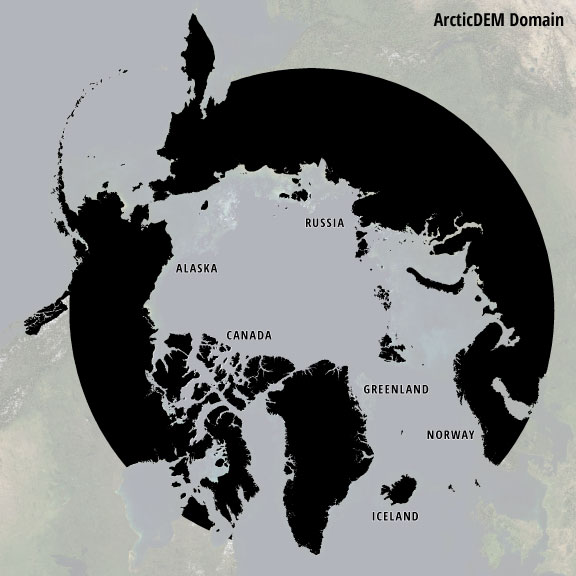
Processing
ArcticDEM data is generated by applying stereo auto-correlation techniques to overlapping pairs of high-resolution optical satellite images.
Using the Surface Extraction from TIN-based Searchspace Minimization (SETSM) software, developed by M.J. Noh and Ian Howat at the Ohio State University, pairs of stereoscopic images are processed to Digital Elevation Models using compute resources provided by the Texas Advanced Computing Center at the University of Texas at Austin and the National Center for Supercomputing Applications at the University of Illinois at Urbana-Champaign.
Output
Output DEM raster files are being made available as both “strip” files as they are output directly from SETSM that preserve the original source material’s temporal component, as well as mosaic files that are compiled by taking the per-pixel median height value from the full stack of strips that cover any given point on the ground.
The time-dependent nature of the strip DEM files allows users to perform change detection analysis and to compare observations of topographic data acquired in different seasons or years. The mosaic DEM tiles are assembled from multiple strip DEMs with the intention of providing a more consistent and comprehensive product over larger areas while also providing a per-pixel minimum and maximum date range to enable change detection.
Documentation
Refer to these guides for official ArcticDEM information & citation.
Citation
Along with acknowledging the PGC, the ArcticDEM dataset should be cited as follows:
Strips:
Porter, Claire, et al., 2022, “ArcticDEM – Strips, Version 4.1”, https://doi.org/10.7910/DVN/C98DVS, Harvard Dataverse, V1, [Date Accessed].
Mosaics:
Porter, Claire, et al., 2023, “ArcticDEM, Version 4.1”, https://doi.org/10.7910/DVN/3VDC4W, Harvard Dataverse, V1, [Date Accessed].
Current Release
Annual DEM Strip Release – 2024
This release includes strip DEMs from calendar year 2024 and before. The archive now includes strip DEMs from 2007-2024. This is the second annual DEM strip release under the Electro-Optical Commercial Layer (EOCL) contract to provide continued public access to historical and new digital elevation models in the Arctic and Antarctic, except Alaska.
See EOCL FAQ for more information
See PGC’s DEM Product Guide for more information
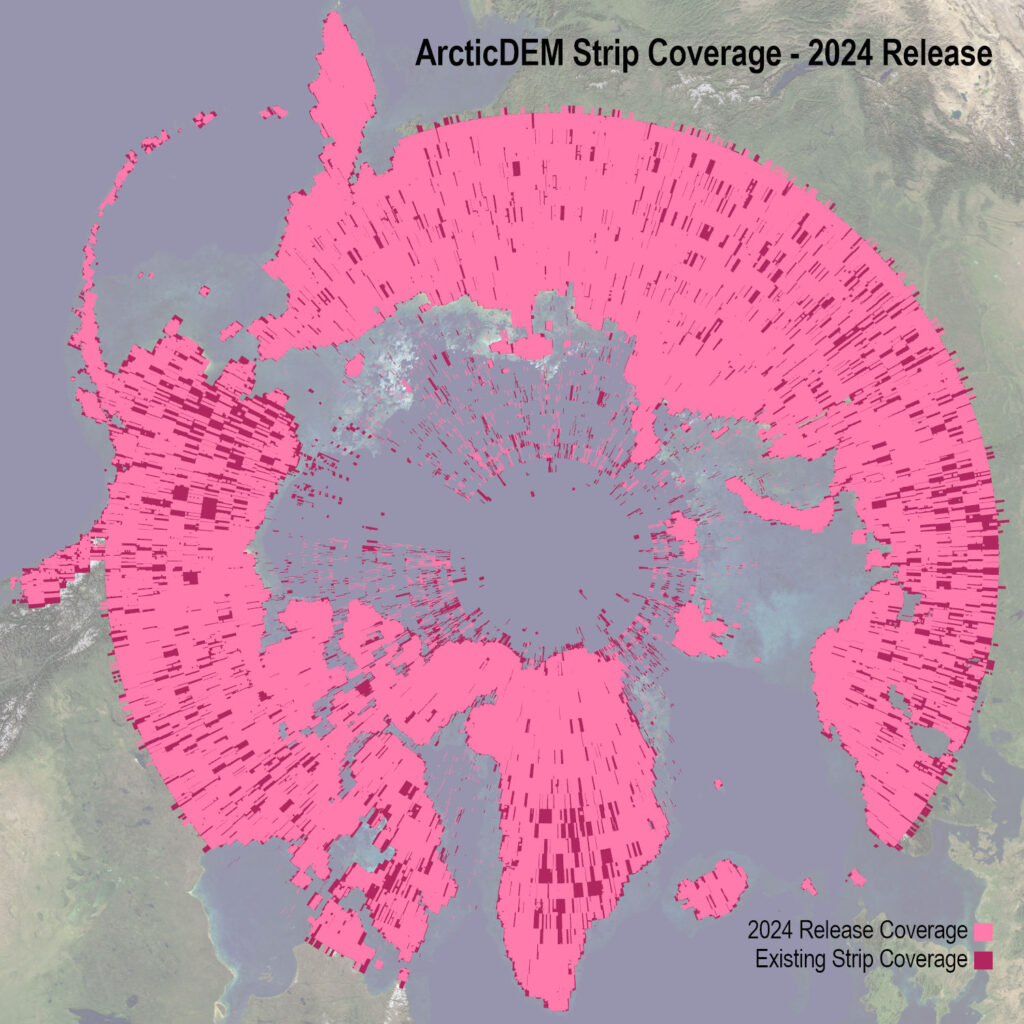
STATISTICS
-
NEW STRIPS
- 60,794
-
RESTRICTIONS
- Alaska after June 2022 is not publicly available due to the EOCL contract
ArcticDEM Strips
Strip DEM files correspond to the overlapping area of the input stereoscopic imagery pair strips as they are collected by Maxar’s constellation of polar-orbiting satellites. Strip DEM dimensions will vary according to the satellite sensor that acquired the images and the off-nadir angle of collection. Most strips are between 13 km and 17 km in width, and 110 km and 120 km in length.
Strip DEM files are provided at 2-meter resolution in 32-bit GeoTIFF format. Elevation units are meters and are referenced to the WGS84 ellipsoid. No ground control or altimetry registration has been applied to the strips.
As of July 2023, an exception to EOCL contract allows for continued public access to historical and newly created ArcticDEM data, except Alaska. For more information about the current license, check out our EOCL FAQ.
STATISTICS
-
TOTAL STRIPS
- 605,596
-
TOTAL STRIP DEM FILE SIZE
- 236 TB
-
STRIP DEM DATES
- 2007-2024
DATA EXTENT
ArcticDEM Strip DEM extent index with links
( SHP | GDB | GPKG | PARQUET )
DATA ACCESS
Browse ArcticDEM Strip DEMs hosted at PGC
Browse Static STAC Catalog with AWS links
Dynamic STAC API Guide
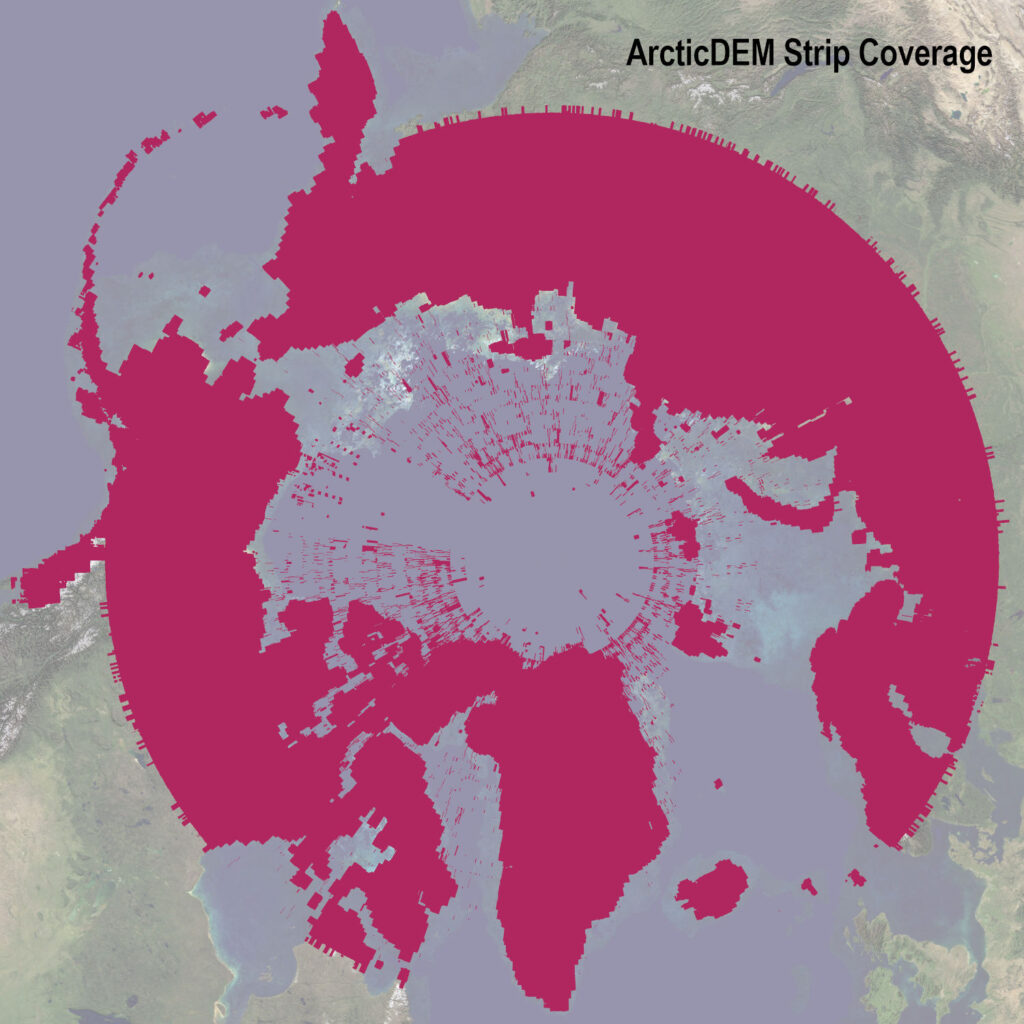
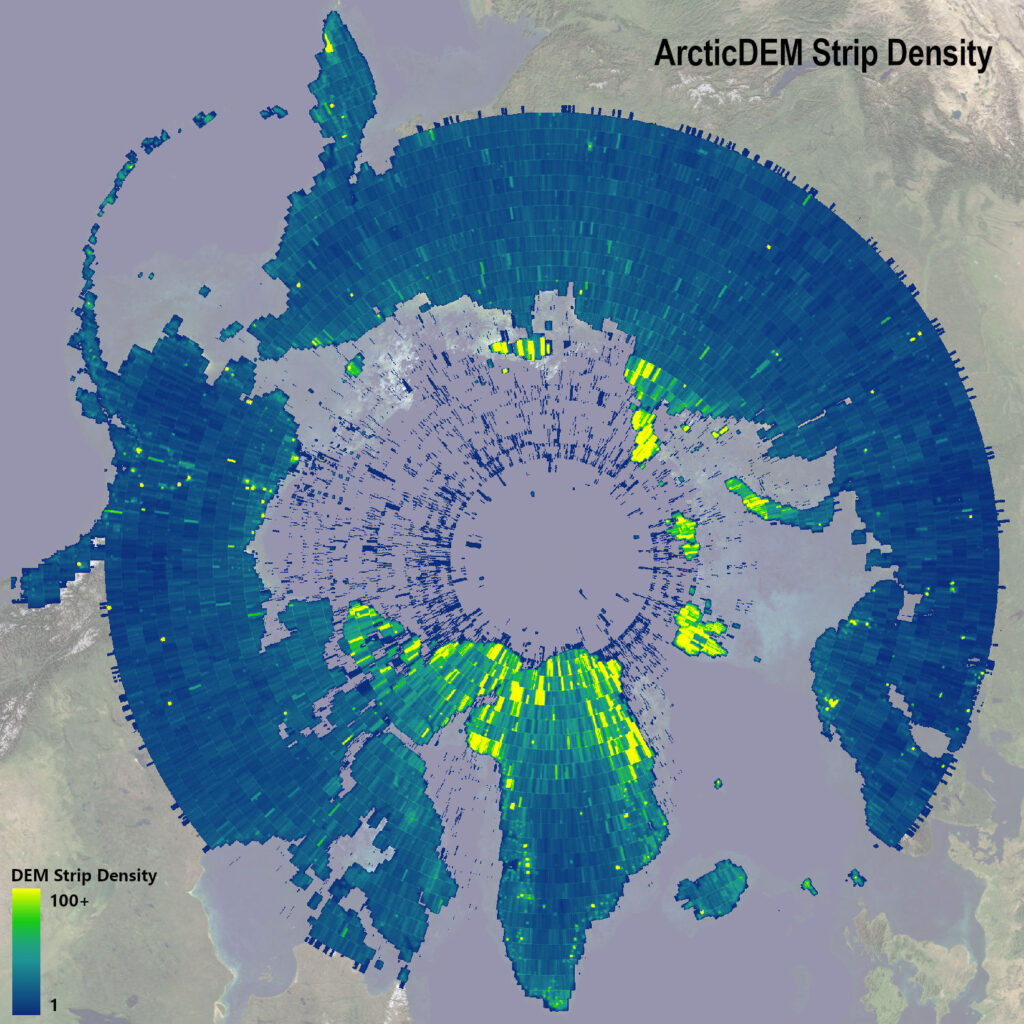
ArcticDEM Mosaic
Version 4.1 Mosaic
Mosaicked DEM files are compiled from the entire stack of strip DEMs. The height value for each pixel in the mosaic is derived from the median value of all contributing strip DEMs to extract a consistent surface with low sensitivity to outlying values. All water bodies identified by the ESA WorldCover 2020 landcover dataset were flattened to a uniform surface height by filling these areas with the Copernicus GLO-30 DEM. Each mosaic tile was independently vertically adjusted to the Copernicus DEM to minimize tile edge artifacts.
Mosaicked DEM files are distributed at full 2-meter spatial resolution as 50 km x 50 km tiles in 32-bit GeoTIFF format. Reduced resolution versions are also available at 10-meter and 32-meter as 100 km x 100 km tiles, and full-domain 100-meter, 500-meter, and 1-kilometer mosaics. Elevation units are meters and are relative to the WGS84 ellipsoid.
ArcticDEM version 4.1 mosaic is built with expanded temporal range, improved median-style mosaicking method, and water flattening. The new mosaic aggregates all 15 years of ArcticDEM data, and fills many of the gaps in the previous version.
View our interactive story map for visualizations of these improvements here:
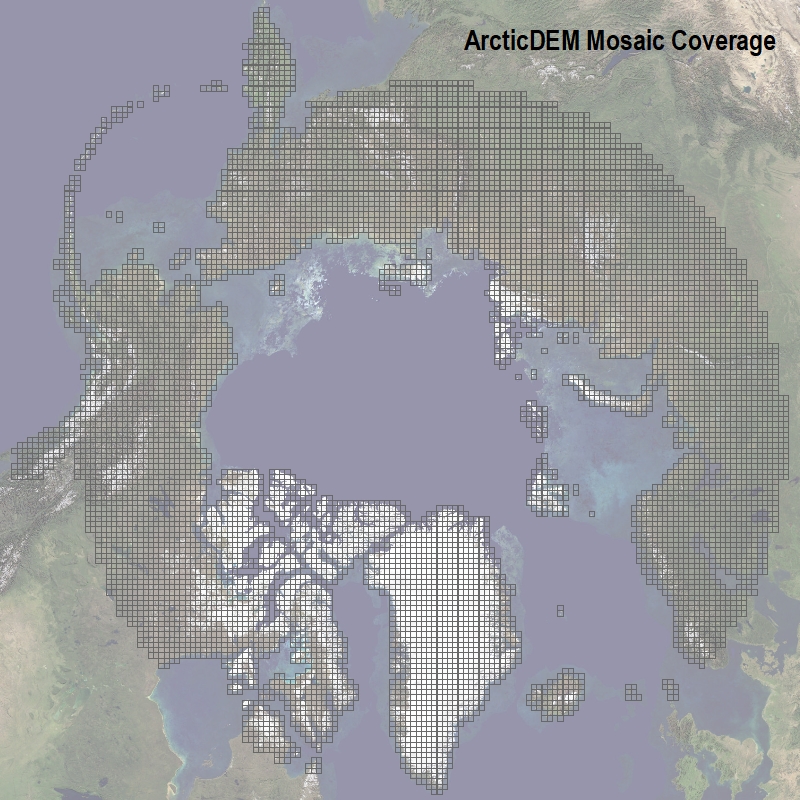
STATISTICS
-
VERSION 4.1 – TOTAL MOSAIC TILES (2m)
- 9,126
-
TOTAL MOSAIC TILE FILE SIZE
- 17 TB
DATA EXTENT
ArcticDEM Mosaic DEM extent index
( SHP | GDB | GPKG | PARQUET )
DATA ACCESS
Browse ArcticDEM Mosaics at multiple resolutions
Browse Static STAC Catalog
Dynamic STAC API Guide
Explore Data
Important information regarding the data explorer applications:
DEMs provided by PGC are relative to the WGS84 ellipsoid, whereas the Esri services have transformed those values to be in geoidal/orthometric heights, also referred as Mean Sea Level (EGM08).
There is no login required for the following apps but Alaska data from 2022-present is not publicly available due to EOCL restrictions. Users with active NSF-OPP for Arctic research can access and request data (including source imagery) from PGC.
Any download or use of ArcticDEM data from the app (or otherwise), must adhere to PGC’s Acknowledgement Policy.
PGC Fridge Data Portal
The PGC Fridge data portal is the best way to preview and download the original datasets (ellipsoidal heights) if no GIS or remote sensing software is available. Users can directly download or choose from a list of DEM products including: full-resolution data, hillshades, masks, metadata, and more. Users with active NSF-OPP funding for Arctic research may access source imagery via Commercial Satellite Imagery login.
PGC STAC Catalog Access
STAC (Spatio Temporal Asset Catalog) is a standard for organizing geospatial data. ArcticDEM’s Static STAC Catalog lets you browse the collection and download assets individually. The Dynamic STAC API facilitates programmatic data queries using python, R, etc.
Esri ArcticDEM Explorer
The Esri ArcticDEM Explorer is the best way to preview datasets of geoidal/orthometric heights (Mean Sea Level) if no GIS or remote sensing software is available or you simply want to explore the entire dataset quickly. The full-resolution strips and mosaics are presented in this web map to quickly preview and explore the elevation data. With this web map, users can visualize the ArcticDEM data, preview the spatial coverage, and download simple exports.
OpenTopography Portal
The OpenTopography Portal platform provides additional tools for visualization and processing, unlike other access points. DEMs of 32m and 10m resolution data products are open to all users while 2m resolution data products are restricted to education and research users. Queries are limited to 2000 sqkm but include Arc ASCII Grid files, GeoTIFFs, and IMGs with a variety of raster visualization options. Datasets are available in the the original datasets (ellipsoidal heights) for delivery.
NGA ArcticDEM Download Tool
The National Geospatial-Intelligence Agency (NGA) ArcticDEM download tool is part of their open data application where publicly released data can be discovered, viewed, and downloaded in a variety of formats. Data is offered for download in several ways. Data can be downloaded as Shapefiles or KML for GIS applications, and CSV for tables and spreadsheets. Additionally, by using the API link, data from this site can be embedded in other applications with the feature service link or GeoJson.
Download from PGC
ArcticDEM Strip DEM extent index – with data download links: (SHP | GDB | GPKG)
ArcticDEM Strip DEM data download via HTTP (browser): https://data.pgc.umn.edu/elev/dem/setsm/ArcticDEM/strips/latest
ArcticDEM Mosaic DEM extent indexes – with data download links: (SHP | GDB | GPKG)
ArcticDEM Mosaic DEM data download via HTTP (browser): https://data.pgc.umn.edu/elev/dem/setsm/ArcticDEM/mosaic/latest
Bulk Download
Use the links below to browse the directory for the entire ArcticDEM dataset. Refer to the User Documentation to see the directory structure, naming schemes, and download contents.
Users familiar with the GNU Wget utility can use the following commands to batch download ArcticDEM data. There is also a Windows version.
Please note, the first two commands will download the entire dataset, which is over 200 TB for strips and 20 TB for mosaics. Use the subdirectory examples to limit your download.
2-meter strips (entire dataset!)
wget -r -N -nH -np -R index.html* --cut-dirs=3 https://data.pgc.umn.edu/elev/dem/setsm/ArcticDEM/strips/s2s041/2m/
2-meter mosaic tiles (entire dataset!)
wget -r -N -nH -np -R index.html* --cut-dirs=3 https://data.pgc.umn.edu/elev/dem/setsm/ArcticDEM/mosaic/v4.1/2m/
2-meter strips (subdirectory example)
wget -r -N -nH -np -R index.html* --cut-dirs=3 https://data.pgc.umn.edu/elev/dem/setsm/ArcticDEM/strips/s2s041/2m/n55e155/
2-meter mosaic tiles (subdirectory example)
wget -r -N -nH -np -R index.html* --cut-dirs=3 https://data.pgc.umn.edu/elev/dem/setsm/ArcticDEM/mosaic/v4.1/2m/15_27/
Download from AWS
Strip DEMs available at 2-meter resolution.
All publicly-available DEM data from our projects are also hosted in an open AWS bucket and indexed with a STAC catalog. DEM data assets can be identified using the DEM STAC items and downloaded or used directly in the cloud.
ArcticDEM AWS Open Data Registry page:
Download from OpenTopography
OpenTopography is distributing the ArcticDEM mosaics (version 4, released August 2023) with value-added tools for access, processing, and visualization.
32m and 10m resolution data products are open to all users.
2m resolution data products are restricted to education and research users.
OpenTopography ArcticDEM page:
VRTs
Users can directly load the mosaic tiles into certain GIS programs and applications without downloading data by using GDAL’s Virtual Format.
ARCTICDEM VRT FILES REPRESENTING 2, 10, AND 32-METER RESOLUTION MOSAICS:
Reference these VRTs in the cloud from your GIS or application or download them locally. Note they can be slow to load initially.
Web Services & Applications
Need help connecting to web service layers? Check out PGC’s guide to using web services in ArcGIS and QGIS to get you started.
ArcticDEM 2m Strip Index
ArcticDEM 2m Tile Index
ArcticDEM Mosaic-only Image Service:
ArcticDEM composite (strip and mosaic) Image Service
-
- REST Endpoint: https://di-pgc.img.arcgis.com/arcgis/rest/services/arcticdem_latest/ImageServer
- ArcGIS Online Item: https://umn.maps.arcgis.com/home/item.html?id=4334ffd98a0a4be685f81157a6fbdeca
- WMS Service: https://di-pgc.img.arcgis.com/arcgis/services/arcticdem_latest/ImageServer/WMSServer
- WCS Service: https://di-pgc.img.arcgis.com/arcgis/services/arcticdem_latest/ImageServer/WCSServer
Maps
Map Poster
A shaded relief version of the ArcticDEM dataset with voids filled and the resolution reduced is available as a 36″x36″ map poster. There are two versions, one that contains cartographic elements such as cities, research sites, and administrative boundaries and one that is just the hillshade image. The maps can be viewed/downloaded below. Please note, these maps are not for use in GIS.
HILLSHADE Version
![]()
View Map
Download Map (pdf)
Cartographic Version
![]()
View Map
Download Map (pdf)
Press
Video
- GEOINT Symposium 2019 Keynote: Vice Admiral Robert Sharp, NGA Director (6/3/2019)
- Blue Waters user Claire Porter Wins NOAA David Johnson Award for ArcticDEM Research (4/16/2019)
- President Barack Obama ArcticDEM Announcement, Kotzebue, Alaska (9/3/2015)
Podcasts
Articles
- NCSA: Blue Waters and Advanced Visualization Lab Co-Produces Award-Winning Documentary “Atlas of a Changing Earth” (12/1/2021)
- Trajectory Magazine: Polar GEOINT (4/29/2019)
- HPC Wire: Blue Waters User Claire Porter Wins NOAA David Johnson Award (4/17/2019)
- NCSA: Blue Waters User Claire Porter Wins NOAA David Johnson Award for ArcticDEM Research (4/16/2019)
- Esri: High Fidelity Polar Elevation (10/29/2018)
- GoGeomatics Canada: CCMEO’s Elevation Data Revolution: Part 2 ArcticDEM development (4/4/2018)
- AGU EOS: Map Provides High-Resolution Look at Nearly Entire Arctic Region (10/24/2017)
- NGA Pathfinder Magazine: Mapping the Arctic from the sky (8/21/2017)
- Esri: Arctic Elevation updated with new, high-resolution data (6/6/2017)
- ArcticDEM Project has now mapped more than 65 percent of the Arctic (6/2/2017)
- White House: New elevation map details Alaska like never before (9/1/2016)
- NSF, NGA release first unclassified digital elevation models of Alaska (9/1/2016)
- University of Minnesota-led project releases 3-D elevation maps of Alaska for White House Arctic Initiative (9/1/2016)
- National Geographic: Alaska has finally been mapped as precisely as Mars (9/1/2016)
- Blue Waters supercomputer used to create 3D elevation models for White House Arctic Initiative (9/1/2016)
- NSF, National Geospatial-Intelligence Agency support development of new Arctic Maps (9/2/2016)
- Esri: GIS makes the picture clearer on climate change (9/6/2016)

